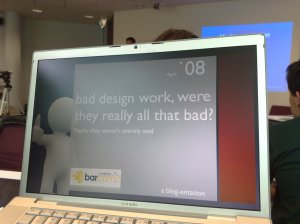I had a conversation today, which was I interesting and enlightening.
We were talking about User Centred Design, and the person I was talking to, let’s call him “Bob”, was all fixated on how UCD was born from the IT age.
I of course argued to the contrary and being an Industrial Designer (actual buttons that you click with your fingres and so on)
You see, UCD in all it’s forms and even as simply as a reseraunt, asking the customer how they like their coffee and thus changing the menu.
It’s alive in the automotive industry like nothing else. Look at the features that appear in the new cars each year, how do you think they arrive at what is on that list? how do you think motorcycles (the finest and most incredible machines this world has ever known) have become such highly focussed and purposed solely for integrating the human with amazing speed and grace?
I digress. But to make my point, I’ll look at a new different product all together. A perambulator.
Specifically a terriffic one made by Britax (Steelcraft), called the “Strider”.
We just got one for our new kid. Me being me, I reviewed it quite carefully when we were purchasing it.
To me, took up the role of the technical, financial, and coach buyer. The boss took up the role of the User buyer, as well as a little bit of the financial buyer.
From my perspectives, having reverse engineered the design, and the product itself:
Technical buyer:
– it’s machined nicely, with all the fittings, … fitting well, and operating it is easy, and well thought out, for a human to work, (who has two hands, TWO not THREE Bertini)
– it was made from good quality extruded aluminium.
– it had solid motion through all its joints, and bushes moved silently without catching or rubbing.
– the tyres were airless, and thus would never run flat, and could have the tread replaced.
– the wheels pop off, and the bassinet pops off easily to reduce stack height when folded down.
– light weight, with minimal plastics and over complicated jointing systems.
Financial buyer:
– in terms of construction cost to produce the item, to the obvious quality standard, seemed reasonable. Easily besting the “could I build it myself for less?” question.
– in terms of quality in comparison to the other things on the market (ahem …http://www.bugaboo.com/ @ $1500AUD for a pram!) and versus the more economical bretheren, certainly seemed to offer good value for money.
– Because of the inherant quality of the product, wear and tear or lifespan questions are well met.
Coach Buyer:
– Because the financial buyer and the techncial buyer (which is a common male role to play in such a decision) were happy, the Coach buyer was provided with many good things to help coach the User buyer into a position of purchase. Why? Because it came with this terriffic two part brochure, the one set of pages, had all the technical information and instructional information I in my roles (and as a male) would want. Plus!!! it had all the information I would need to be able to support my actual decision maker in her decision.
Of note, it wasn’t a con, or underhanded in my view. Because Britax gave me all the information I wanted to know, and made the product in such a way that it addressed my concerns, my job in my role was made easier.
From the Boss’s side, she got great usability, reassurance from her technical and financial buyer that the thing was good, and to boot, because the financials were reasonable.. heaps of extras for bub.
Which suited me also.
So where’s the UCD in all this?
I’ll ask you this.
We bought the pram. We’re happy about it, we like it, like to use it, and had no post purchase buyers remorse.
How do you think the company could have achieved that, if they DIDN’T ask users what they wanted and then acted upon that information?







